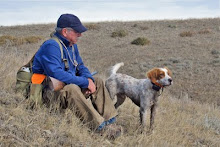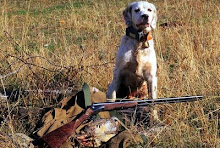
Old news to some people, but new to me is the 'discovery' and investigation of the Carolina dog...
Dr. I. Lehr Brisbin Jr., a Senior Research Ecologist at the University of Georgia's Savannah River Ecology Lab, first came across a Carolina Dog while working at the Savannah River site. Horace, a stray white dog with brown markings, was wandering the site’s boundary when he caught Brisbin’s attention. Brisbin, who had seen many rural dogs chained to the back of porches and doghouses, assumed this was just a normal stray. Many of these dogs roamed the woods and would turn up in humane traps, and Brisbin began to wonder how many more of these were in the wild. On a hunch, he went to the pound and was surprised by the resemblance the dog had to dingoes.
The preliminary DNA testing provided an intriguing link between primitive dogs and Carolina Dogs. Brisbin stated, “We grabbed them out of the woods based on what they look like, and if they were just dogs their DNA patterns should be well distributed throughout the canine family tree. But they aren't. They're all at the base of the tree, where you would find very primitive dogs.” This wasn’t conclusive, but it did spark interest into more extensive DNA testing.
The exciting idea remains a hypothesis, one that's under examination by an analysis of fossils, cave paintings, and other pieces of the North American historical record. Early paintings of Native Americans, for example, show accompanying dogs whose appearance looks strikingly like today's Carolina Dogs.
Another suggestive piece of evidence is comparison with dogs that remain on the other side of the long vanished Asia-North America land connection."It's a hypothesis," Brisbin stressed, "but we might infer that if dogs look similar on both sides of the Bering Strait land bridge, maybe our first American dogs came over from that area." On Chindo Island, Korea, local free-ranging dogs exist that have apparently been free from hybridization by other breeds. "That native Korean breed, the chindo-kae, is indistinguishable from Carolina Dogs, Brisbin noted. "If they were mixed in a group, I couldn't tell who was who."
The distinctive appearance of Carolina Dogs is not their only link to the world's surviving primitive breeds. Brisbin's studies have also revealed behaviors not observed in domestic dogs.
For more... National Geographic









1 comment:
Carolina Dogs are typical pariah morphotypic dogs of mixed ancestry. There is very little evidence (genetic or otherwise) to connect them with the ancient aboriginal dogs of the SE US. The original testing performed in the late '90s ( I was working with Dr. Brisbin and others at the time) was, at best, inconclusive--showing that some Carolina Dogs tested could be grouped with other primitive dog breeds/types. But so can Chows, Huskies, German Shepherds and other domestic breeds that probably went into several strains of registered "purebred" Carolina dog bloodlines. All these breeds have been, at one time or other, extremely popular, with many of each breed most likely discarded or turned loose when they proved to be too much to handle. These strays (those who survived) would then be free to mix into the general stray/pariah/feral dog population of remote, rural areas.I know firsthand of registered Carolina Dogs with long coats and blue eyes--obvious evidence of possible recent husky/chow influence.
Carolina Dogs are basically populations of dogs of European (domestic) descent who have, over successive generations, and through the process of natural selection, reverted back to a primitive behavioral/morphological/ecologicaI phenotype. These dogs would be physically similar, or possibly identical to the aboriginal dogs present prior to European settlement (though not genetically related), due to both being created through the pressures of natural selection. The Carolina Dog would represent domestication in reverse. This would be a situation where a completely domesticated animal would have fled to the wilds/semiwilds of the rural SE US to evolve as a completely new type (breed) free of direct human intervention and/or supervision. Those domestic physical and behavioral traits not suited for survival in the wild would have been selected against and removed from the gene pool. This would represent a reemergence of the "original dog type" which first emerged over 12,000 years ago. Such pariah types exist all over the world and are by no means unique. Technically, a "Carolina Dog" would be a dog born from UKC/ARBA registered parents--a pedigreed dog or one allowed into the breeding program by Dr. Brisbin or his associates. In other words, the Carolina Dog "breed" was created from mixed pariah dog stock taken from the rural SE US and turned into a registered breed--just like the Canaan Dog, the Telomian, the Basenji, the Santal Hound, etc. in other parts of the world.
Post a Comment